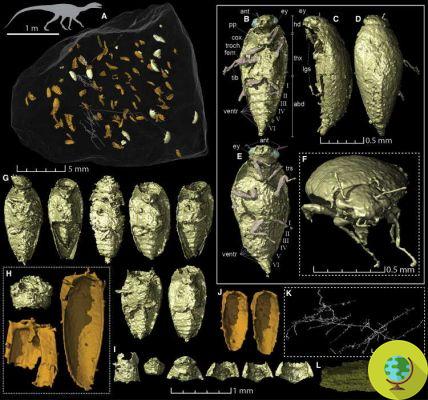It is 230 million years old and is the first insect found perfectly intact in the fossilized feces of a dinosaur
He is about to end up run over, his mother saves himIt is the first insect found perfectly intact in the fossilized feces of a dinosaur. Called Triamyxa coprolytica (a beetle), it is 230 million years old. The fascinating discovery is the work of a research group led by the University of Uppsala (Sweden).
Fossilized feces, also called coprolites, are actually abundant in museums and research collections around the world, but few scientists have examined their contents, especially since researchers did not think that small insects could successfully pass through a digestive system and be found intact or almost. Thus paleontologists have obtained most of the information on the evolution of insects from the unfortunate ones trapped in amber or the fossil resin of trees.
Uppsala's research therefore represents almost a unicum of its kind: the scientists, in particular, examined fossil excrement from Poland about 230 million years ago, selecting a fragment almost 2 centimeters long whose shape suggested it belonged to an excrement much bigger.
The entire sample was then subjected to a thorough x-ray analysis, managing to recreate 3D reconstructions of its contents. The results stunned the scientists themselves: the images showed indeed incredibly preserved insects, almost intact and 1,4 millimeters long, as well as fragments such as heads, antennae and legs.
The new species came from dung allegedly expelled from Silesaurus opolensis, an ancestor of the 2,3 meter long beaked dinosaur, and the beetles were well preserved because the coprolites act as microenvironments capable of preserving organic material, including soft tissue, without the flattening that characterizes other fossil types.
The insect found, now extinct, probably belonged to a group known as Myxophaga, a family of small beetles that thrive on algae in humid habitats: the team classified it taxonomically by noting shared characteristics, such as the number of segments of the abdomen or the location. of the antennae, to the modern Myxophaga, of which four lineages still survive.
We have found fragments [of insects in fossilized feces] before - explains Martin Qvarnström, first author of the research - but not enough to describe a new species, genus and family like this.

©Current Biology
The research has not only found new beetle species, but it delivers also information on diets and environments of the animals that ate them, the researchers explain. Such analyzes can then help scientists understand ancient food webs and how the ancestors of dinosaurs lived and interacted in this ancient ecosystem. By scanning earlier and later coprolites in the Triassic period, the team also hopes to reconstruct the evolution of insects as well.
Regarding this in particular, the researchers say there is currently no way of knowing why it went extinct while its cousins survived into the modern era, but it is likely that it was a combination of random events and sheer bad luck.
The work was published in Current Biology.
Sources of reference: ScienceMag.org / Current Biology
Read also:
- Infernal ant attacks an insect: the incredible scene is 100 million years old and has remained "immortalized" in amber
- The oldest bee in history is 100 million years old: fossilized insect with pollen found


























